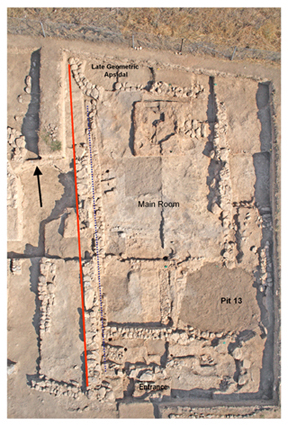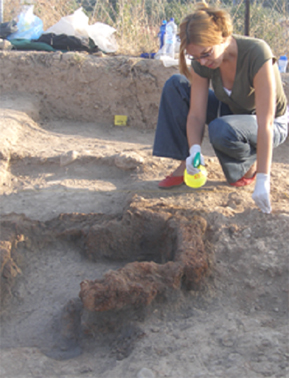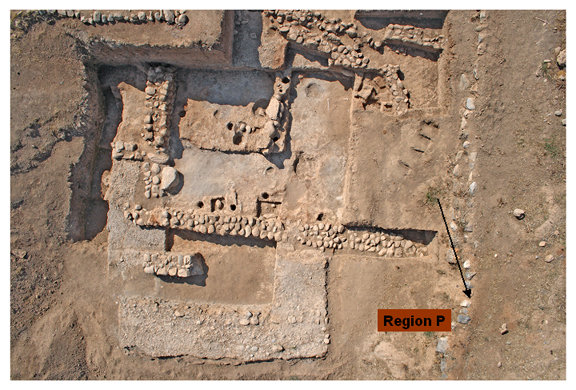
LEFKANDI-XEROPOLIS 2007 SEASON– Region I
Area M
The Early Iron Age ‘Megaron’ and it LH IIIC Predecessor
By the end of 2006 the ‘megaron’ had been effectively revealed and excavated down to its flooring; its close physical proximity to an underlying Late Bronze Age structure was also clear. This year the removal of its flooring/packing and any other lower soils was carried out – down to the latest LH IIIC floors.
It was also confirmed that the Early Iron Age building seemed to have only one floor-surface - mostly mudbricks or earth mixes of that kind. Some additional post holes of this phase were also discovered this year.
 |
The Early Iron Age 'Megaron' and its Late Helladic IIIC Predecessor |
Like its Iron Age successor, the Late Bronze Age building is long and rectangular in plan (at least 12m North/South by 5.5m East/West). At the South end, the building was divided into two small compartments. The eastern one was used as its entrance. A central room probably formed the main part of the building, while in the north end there may have been another room, but hill erosion and the erection of later Late Geometric apsidal house have done much damage.
The building was entered, probably via a threshold placed just east of the central median line (where the incorporation of its successor has somewhat confused the area). There are slight indications of some sort of porch or walls in antis at the East end. At the West end some postholes might indicate something similar there too but the later walls cover much of the relevant area. The South/East Room is defined at the West by Wall 153 and at the north by the East/West cross Wall 149; the room had a further access through a door-way at the North/East. Otherwise the South/East Room was completely disturbed and destroyed by Pit 13 which was dug in the area during the Late Geometric Period.
The Main Room (which is 7.5 x 5.5m in size), has been found remarkably empty. One median posthole and evidence of mudbrick furniture to the North/West have been discovered so far. But at the North end of the Room, and in particular at the East part of this area, a stone construction is visible running East/West. It has a roughly flat and uneven surface and sits on a few centimeters of soil above the latest floors of the room. Interestingly, it is covered by a thick yellow clay spread that runs on beyond it, and under the floors of the later Early Iron Age building. At present it is hard to decide whether the structure belongs to the Late Bronze or to the Iron Age building. On balance, and considering the manner in which the latest LH IIIC floor to the north runs off the edge of the stone structure (though this is also because of the presence of even earlier walls below), it seems that it was built sometime during the end of the use of the LH IIIC structure. Its full extent to the west is masked by the block of soil left to support the 'fire-box' (see below).
 |
The conservator at the 'structure' found in the North end of the 'Megaron' |
Another interesting observation is that in several places the LH IIIC walls have been incorporated and reused by the Early Iron Age builders (for examples Walls 77 and 88). It appears however that in some other parts earlier constructions were completely ignored. We also observed that in some places the mudbrick floors of the Early Iron Age ‘megaron’ rest only on a few centimeters above the floors of its predecessor.
Elsewhere, however, some 20-30 cm of an intervening one-phase fill may exist. These observations suggest at present that first the major LH IIIC walls were reduced to their stone socles before the construction of the Early Iron Age building began and a similar conclusion applies to the interior space too which was emptied by the later builders. Why such an operation took place and what it implies for the function of the building is hard to say at present.
It appears, however, that within this period of transition another odd ‘feature’ appeared at the north end and on the medial axis of more or less both earlier and later buildings. This a ‘box’ made of mudbricks (70 cm East/West by 40 cm North/South). Within the 'box' and spilling out from it was a very fine grey to black soil (of the sort often called 'ashy', and associated with decayed or burnt vegetable/organic matter). About half way down was part of coarse made pot (other parts of it were located just outside the 'box'), and some half-dozen murex shells that had been subjected to considerable heat (according to our shell specialist who examined them).
Area P
The multi-phased complex
It was clear after the end of last year’s excavation of the complex located in the southern part of the plot excavated by Popham and Sackett in the 1960s, that both its west and south parts required further investigation.
At the end of this year’s excavation, it is confirmed that the complex was used from the LH IIIC phases to the Late Geometric and Archaic. The LH IIIC structure revealed in 2006 belongs to Lefkandi Phase 3. This discovery will probably clarify in the future the rather confusing report of the so-called South House excavated by Popham and Sackett (Lefkandi IV, 41-2). Our complex might even be part of it. It is also now clear that the building extended to the west, east, and south and it includes part of the north side of Area P which was excavated in 2004 and 2006. If this is indeed the case, then the complex is of some considerable size. Providing that the preliminary dating of the structure is correct (Lefkandi - Phase 3), it is interesting that its construction and size is not inferior of houses dated to Phase 2 as defined by Popham and Sackett.
 |
The Complex in Area P |
Following a collapse of the above LH IIIC- Phase 3 structure, evinced by an infill of mudbricks, the area was occupied again with the construction of new walls but also the reuse of some earlier LH IIIC ones (for example Wall 94 was partly reused, while Wall 130/112 was most probably utilized as an internal division). Wall 141 on the South is also new. Pottery found in these levels could belong to the transitional phases from the Late Bronze to the Iron Age.
During the Protogeometric period (roughly tenth century) the excavated part of the structure is some 5 m wide and extends to both West and East but also outside the area investigated so far. Interestingly, to the North of the structure, an exterior space (perhaps a yard) laid with pebbles has produced a considerable amount of butchered animal bone. E. Christodoulou (animal bones specialist) suggests that the area was most probably used as butchery.
The preliminary study of the pottery suggests that the Early Iron Age structure had at least two phases of occupation. The earliest is marked by some sort of burnt debris in the eastern room above which some good quality pebble-laid floors were found. Both these phases are dated within the Protogeometric and Sub-Protogeometric periods.
Home > New Excavations >2007 Season > 2007 Season Region I> Region II
Copyright © 2009, http://lefkandi.classics.ox.ac.uk/
Any reproduction without expressed written consent is strictly prohibited